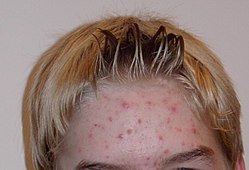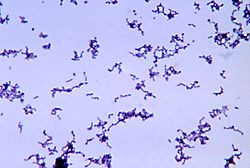Gram-positive non-sporulating anaerobes
Gram-positive non-sporulating anaerobes include Actinomycetes spp., Propionibacterium spp., Lactobacilus spp., Peptostreptococcus spp..
These representatives have several features in common. They occur in the common microflora of the oral cavity, nasopharynx, vagina, colon or in skin. It is involved in the development of infections. They cause diseases like actinomycosis, acne or endocarditis. In terms of morphology, they occur as rods and have branched fibers that turn into coccoidal formations. Cultivation is not always easy, the most important thing is microscopy of the material due to growth, which can take up to a week.
Actinomycetes spp.[edit | edit source]
Actinomycetes are gram-positive non-sporulating anaerobes, inducing cerebral, thoracic and abdominal actinomycosis, which is a surgical purulent disease with abscesses. Actinomycetes have pleomorphic branched fibers with a tendency for terminal fragmentation. They are V-shaped or Y-shaped (like a fungal mycelium). Their wall is species-specific with peptidoglycan and mycolic acid. They ferment glucose. If glucose is added to the culture medium, it will trigger their growth. They are also microaerophilic , but under the presence of carbon dioxide. They occur mainly in the vagina , oral cavity and urogenital.
Sampling is done from the depth of the sinus and the colonies they form have a molar shape. It is difficult to cultivate them.
An important representative is A. israeli causing actinomycosis. An abscess and a fistula with a thick pus and drusen (granular clusters of microbes) is formed. Actinomycosis can be thoracic, cervicofacial, abdominal or also in uterine form. Actinomycosis is treated with penicillin or doxycycline, lincomycin, clindamycin . We prove it directly - by microscopy or anaerobic cultivation.
Propionibacterium spp.[edit | edit source]
These agents occur in the skin, nasopharynx, GIT, oral cavity and in urogenital. They most often occur as non-sporulating anaerobes. They are of club shape (like loose tea). They produce lipases and cause acne – acne juvenilis. Acne is treated with regular skin cleansing and clindamycin.
Peptostreptococcus spp.[edit | edit source]
The most common ones are P. magnus, anaerobicus, asaccharolyticus. They cause infections of oral cavity, postpartum endometritis, small pelvic inflammation, peritonsillar abscesses, necrotizing pneumonia and other diseases. During therapy, it is important to determine the cause and surgically clean the lesion. He is being treated with penicillin or cefoxitin. They are detected in clinical material from pus, wound swabs or from amniotic fluid.
Lactobacilus spp.[edit | edit source]
Less significant representatives include Bifidobacterium spp. causing dental caries.
Links[edit | edit source]
Related articles[edit | edit source]
Bibliography[edit | edit source]
- VOTAVA, Miroslav. Lékařská mikrobiologie speciální. 1. edition. Brno : Neptun, 2003. 495 pp. ISBN 80-902896-6-5.
- BEDNÁŘ, Marek – SOUČEK, Andrej – FRAŇKOVÁ, Věra, et al. medical microbiology : Bacteriology, virology, parasitology. 1. edition. Praha : Marvil, 1996. 558 pp. ISBN 8023802976.





